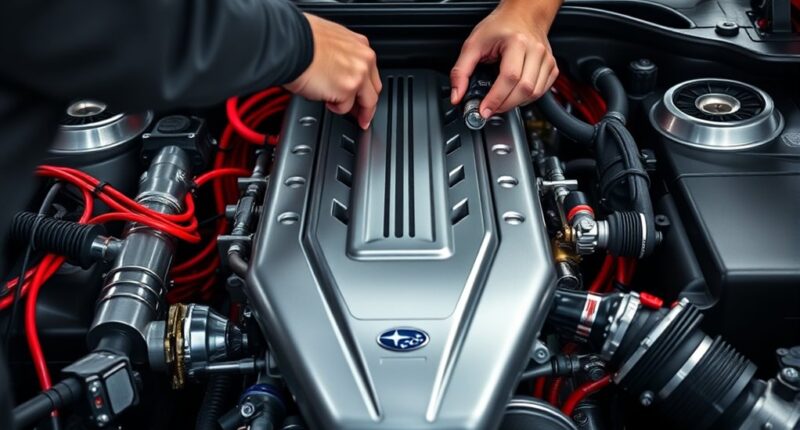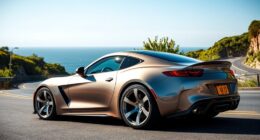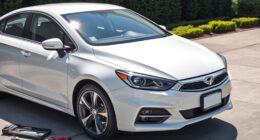To install a tuner on your Subaru BRZ or WRX, start by preparing the vehicle—clean the engine, verify fluid levels, and inspect sensors. Connect your chosen tuning device, such as a COBB Accessport, and back up your original ECU. Use the software to load performance maps, then safely flash the ECU. Afterward, check for leaks, monitor engine health, and confirm the tune’s effectiveness. If you keep exploring, you’ll discover tips for safe, best tuning and maintenance.
Key Takeaways
- Prepare your vehicle by cleaning the engine, verifying fluids, and inspecting sensors before beginning tuner installation.
- Identify your ECU type and choose compatible tuning devices like COBB Accessport or open-source options.
- Connect your laptop securely to the ECU using the proper interface, then backup the original map before flashing the new tune.
- Follow step-by-step instructions to install the tune, ensuring proper voltage, connection stability, and software usage.
- After installation, perform post-tune checks such as oil pressure, leaks, and vibration assessments to ensure safe operation.
Understanding the Benefits of Tuning Your Subaru BRZ and WRX
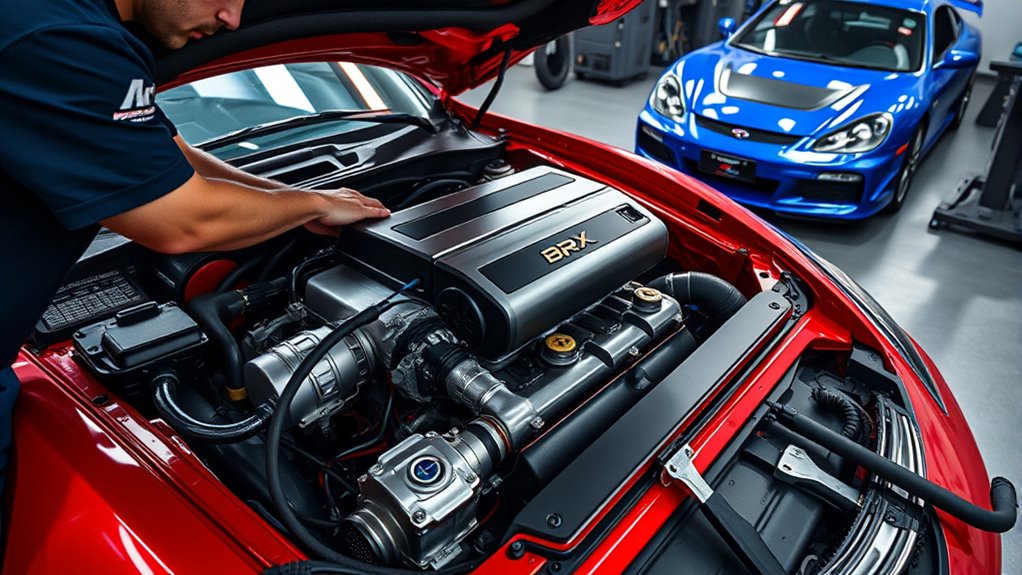
Tuning your Subaru BRZ or WRX opens a range of performance, drivability, and efficiency benefits that can considerably enhance your driving experience. You’ll see increased horsepower and torque by optimizing fuel and air ratios, along with ignition timing. Torque dips get minimized, ensuring smoother power delivery across RPMs, while boost pressure adjustments improve acceleration. Full use of aftermarket hardware like downpipes maximizes output, and CAN Flex Fuel systems let you utilize ethanol blends for higher power potential. Drivability improves with smoother throttle response, refined idle quality, and predictable power delivery, making daily driving more comfortable. Additionally, tuning helps protect your engine’s longevity by preventing lean or rich conditions and managing temperatures. You’ll also enjoy better fuel efficiency through precise combustion adjustments and ethanol flexibility, all while maintaining emissions compliance. Understanding performance tuning laws can help you avoid legal issues and ensure your modifications remain compliant with regulations. Proper tuning can also enhance the handling characteristics of your Subaru, providing better control and stability during spirited driving.
Selecting the Right Tuning Device: COBB Accessport and Alternatives

Choosing the right tuning device for your Subaru BRZ or WRX depends on your goals, budget, and technical skill level. The COBB Accessport V3 is popular for its plug-and-play design, making installation straightforward for beginners. It offers customizable maps for supporting performance mods like intakes and exhausts, and works well with both RWD BRZ and AWD WRX, though tuning complexity varies. If you’re on a tighter budget or want deeper customization, open-source options like EcuTeK or RomRaider are available but require technical knowledge. Alternatives like AEM Infinity ECUs provide advanced standalone tuning, perfect for experienced tuners. Consider your vehicle’s specific model year, modification goals, and whether preserving warranty coverage is important, as COBB’s preloaded maps often avoid warranty issues.
Preparing Your Vehicle for Tuner Installation

Before installing a tuner on your Subaru BRZ or WRX, it’s important to make certain your vehicle is properly prepared. This ensures a smooth installation process and *best* performance afterward. Start by cleaning the engine thoroughly to remove dirt and debris, and clean the MAF sensor for accurate readings. Check all oil and fluid levels, topping them off as needed to prevent damage. Inspect and clean the throttle body and intake manifold to avoid airflow restrictions. Additionally, understanding how automation in business can influence vehicle modifications might help in planning future enhancements.
To further optimize your tuning process, it’s beneficial to familiarize yourself with GMC tuning principles to understand the potential performance improvements.
- *Guarantee* the engine is clean and free of debris
- Clean the MAF sensor for accurate tuning
- Verify oil and fluid levels are correct
- Inspect and clean the throttle body and intake manifold
- Confirm all sensors and wiring are in good condition
- Recognize that exploration and discovery can inspire innovative vehicle upgrades and customization approaches.
Step-by-Step Guide to Installing the Tuner on Your Subaru
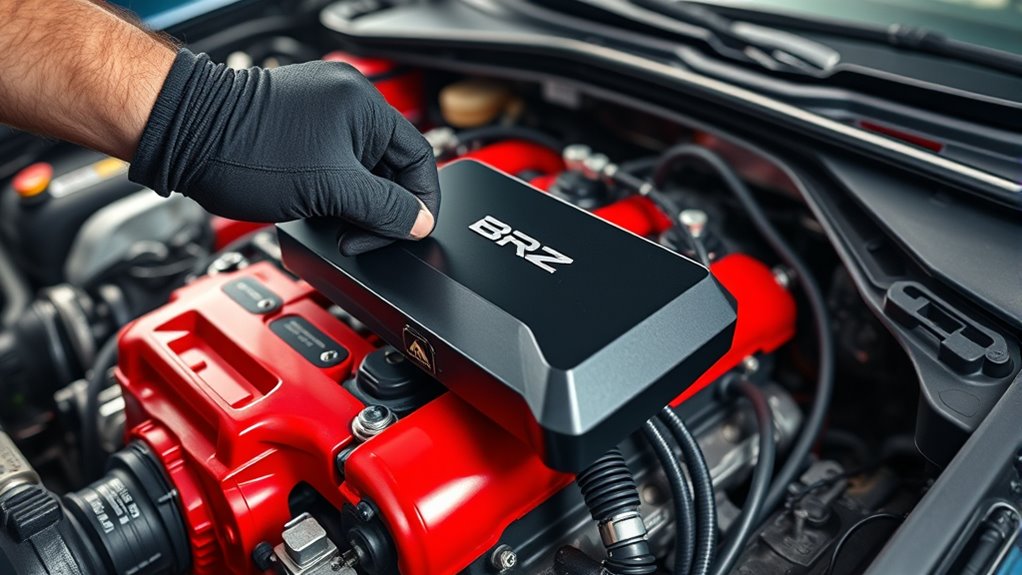
Installing a tuner on your Subaru requires careful attention to each step to guarantee a successful flash and peak performance. First, identify your ECU type to ensure compatibility. Connect your laptop to the vehicle using the appropriate interface cable, making sure all connections are secure. Confirm the vehicle’s power supply, and if necessary, jump the flash connector to provide consistent power during the process. Launch the ECU flash software and follow the prompts, ensuring you have a backup of the original ECU file before proceeding. Carefully write the new tuned file to the ECU, then verify the process completes successfully. Once finished, disconnect everything, and prepare for a test drive to confirm the tuning has been properly installed and your vehicle operates smoothly.
Ensuring Safe and Effective ECU Flashes
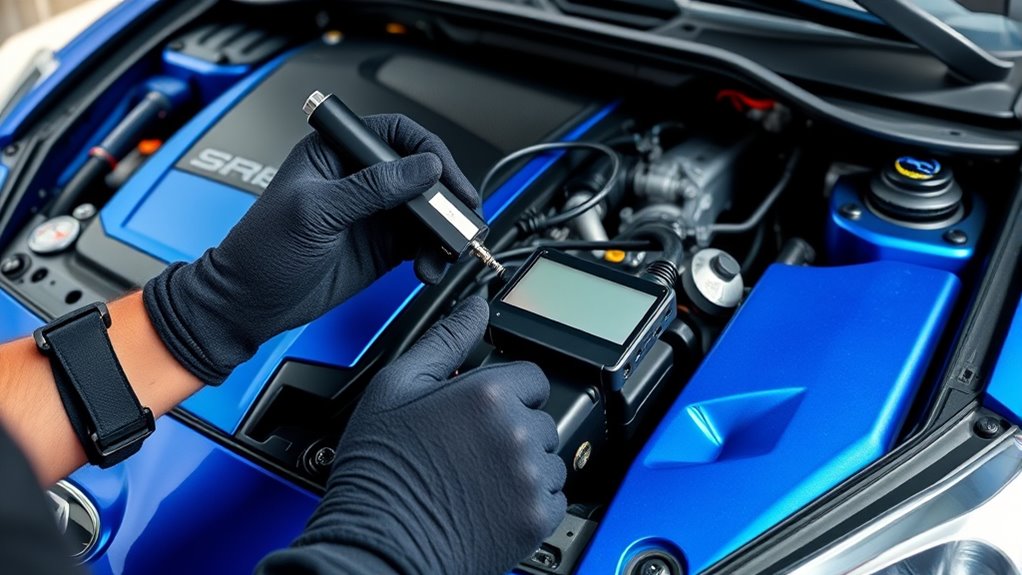
To guarantee your ECU flash is both safe and effective, you need to validate compatibility between your hardware, software, and vehicle. This prevents errors and ensures a smooth tuning process. First, back up your original ECU configuration by performing a full ROM backup and verifying its checksum. Store backups in multiple locations and document the OEM calibration version. Next, confirm your Tactrix or COBB dongle matches your ECU protocol, and check your firmware and software versions. Always test USB connectivity before flashing. During the process, monitor voltage levels—use a stable 12V power source and avoid relying solely on your laptop battery. Keep accessory electronics off and have recovery tools ready. These steps minimize risks and set the foundation for a safe, effective ECU flash. Additionally, understanding ECU protocols helps ensure compatibility and reduces the risk of bricking your ECU during the tuning process. Knowing the best practices in ECU tuning can further enhance safety and success. Properly managing hardware compatibility is also essential to prevent potential issues during flashing, especially considering the importance of device calibration in maintaining optimal performance. Ensuring proper software updates are applied can also prevent compatibility issues and improve tuning reliability.
Choosing the Appropriate Performance Maps and Modifications
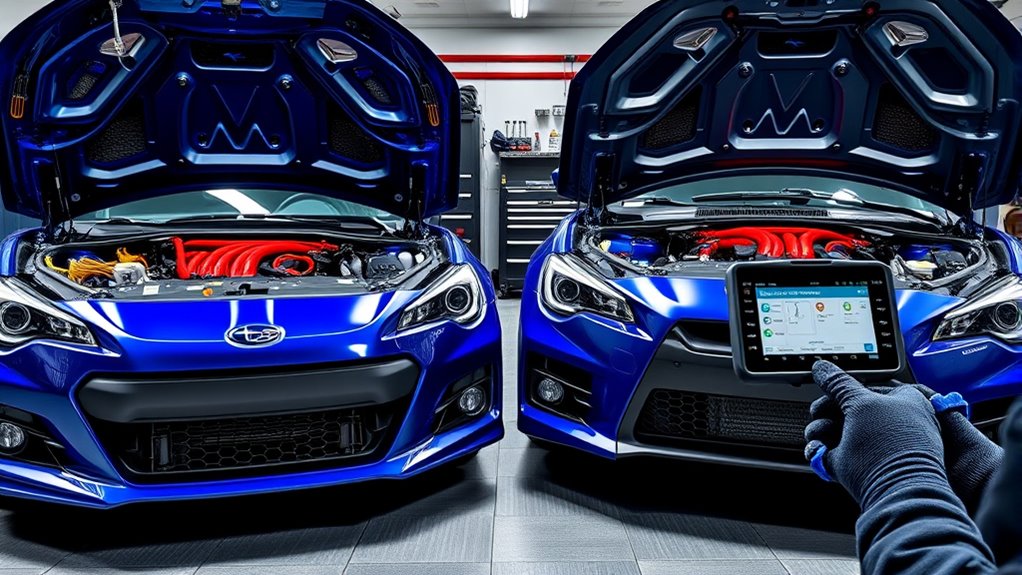
Choosing the right performance maps and modifications is essential to revealing your Subaru’s full potential while maintaining reliability and drivability. For the WRX, focus on turbo-specific maps that optimize boost control and fuel delivery, especially when upgrading the intercooler, downpipe, or exhaust. Drivetrain-aware tuning is vital to preserve traction and balance across all-wheel drive systems. For the BRZ, prioritize NA maps that enhance air/fuel ratios and ignition timing, especially when upgrading intake or exhaust components. E85 compatibility allows for more aggressive tuning, but requires precise fuel and ignition adjustments. Always consider emissions requirements, fuel availability, and thermal limits. Data logging and safety margins should guide your map selection, ensuring your modifications work harmoniously without compromising engine health or driveability. Additionally, understanding performance tuning principles can help optimize your vehicle’s capabilities safely. Incorporating advanced engine controls can further refine the tuning process and improve overall performance. Moreover, staying informed about emissions regulations is crucial to ensure your modifications remain compliant with local laws and standards.
Post-Installation Checks and Optimal Tuning Practices
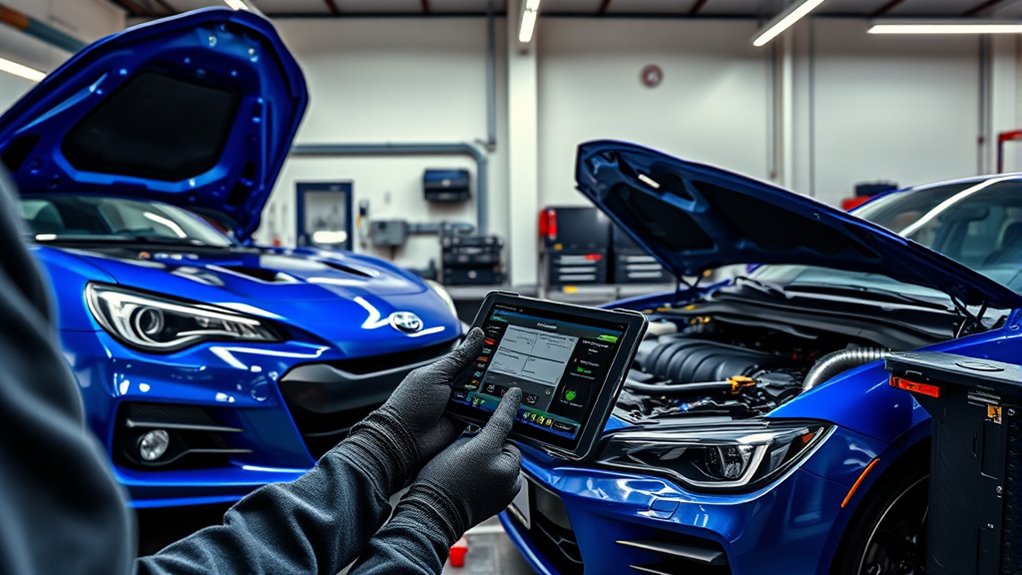
Ensuring your Subaru BRZ or WRX runs smoothly after installation is essential for reliable performance and longevity. Proper post-installation checks help catch issues early and optimize tuning results. Start by verifying that oil pressure is above 30 psi to prevent engine damage. Confirm the clutch pedal adjustment to avoid premature wear. Inspect under the vehicle for oil or coolant leaks that could signal installation problems. Make sure your cooling system is adequately sized and all components are in good condition. Additionally, assessing sound vibrations and their influence on engine components can help maintain optimal health. Regularly monitoring performance metrics ensures your vehicle maintains its tuned settings and operates efficiently over time. Understanding regional legal resources can also be beneficial if you encounter any warranty or service issues related to modifications. Being aware of gasket integrity is important to prevent potential leaks that could compromise your engine’s performance. Incorporating digital literacy in your vehicle maintenance routine, such as using diagnostic apps, can provide real-time insights and help detect issues early.
Frequently Asked Questions
Can I Revert My ECU to Stock After Tuning?
Yes, you can revert your ECU to stock after tuning. You’ll need to flash the original stock ROM, which restores factory settings. If you used an AccessPort, uninstall it to fully revert. Make sure to use the correct fuel type and follow proper procedures to avoid engine damage. Sometimes, professional help is necessary, especially with custom tunes, to ensure the ECU is correctly reset and ready for stock operation.
Is Professional Tuning Necessary for My Subaru BRZ or WRX?
You’re wondering if professional tuning is necessary for your Subaru BRZ or WRX. While some basic upgrades might run fine with an off-the-shelf tune, most performance modifications—like intakes, exhausts, or forced induction—really benefit from custom tuning. It guarantees your engine runs safely, optimizes power, and maintains reliability. Skipping professional tuning risks engine knock, reduced lifespan, poor throttle response, and potential warranty issues. It’s a smart investment for peak performance.
How Often Should I Update My Tuning Maps?
You might think once a tune’s dialed in, you’re set, but regular updates actually enhance performance and reliability. Data shows that tuning maps should be revised every 3 to 5 revisions during the initial two months of modifications, especially when adding new mods or changing fuel types. Monitoring datalogs every 500-1,000 miles helps catch anomalies early, ensuring your car runs smoothly and stays tuned for ideal power and efficiency.
Will Tuning Affect My Vehicle’s Warranty Coverage?
Tuning can impact your vehicle’s warranty because modifications that change engine performance are often seen as voiding coverage. If you install aftermarket tunes or ECU flashes, dealerships might detect these changes and deny warranty claims. To minimize risks, choose removable mods, keep detailed records, and consider discussing your plans with the dealer. Remember, some tuning options like JB4 may offer more flexibility without risking warranty coverage.
Are There Legal Restrictions for Tuning in My Area?
Your question is like steering a minefield; legal restrictions vary widely. In California, you must stick to CARB-certified parts to stay on the right side of the law. Elsewhere, regulations may include TÜV or homologation requirements, potential taxes, or fines for non-compliance. Always check regional rules before tuning, because what’s legal in one place could be a costly mistake elsewhere. Stay informed, and you’ll keep your ride legal and smooth.
Conclusion
Think of tuning your Subaru BRZ or WRX as fine-tuning a musical instrument—you’re making every note count. With the right tools and careful installation, you’ll release smoother performance and more power. Just like a skilled musician, your car needs precision and patience to sound its best. So, take your time, follow the steps, and enjoy the symphony of your upgraded ride. Your driving experience will be music to your ears.
